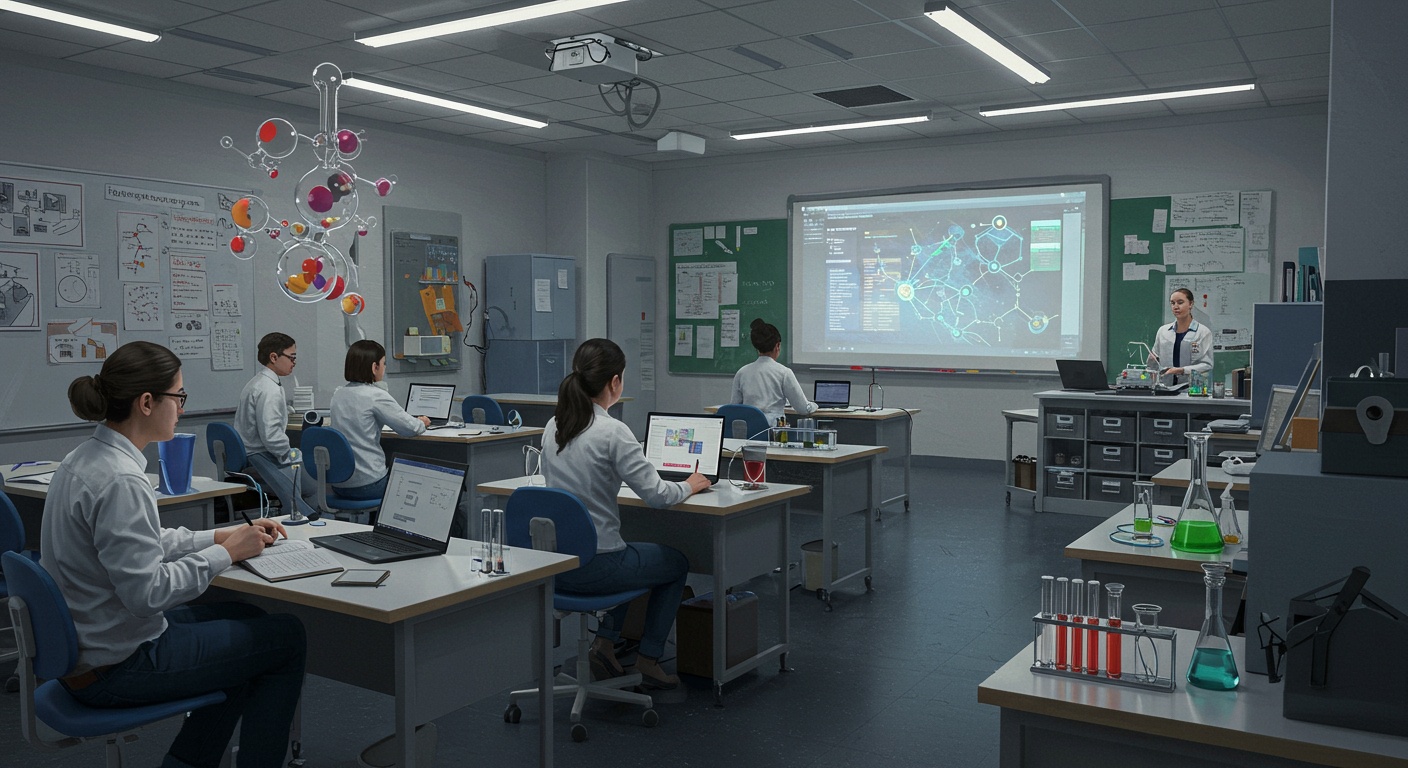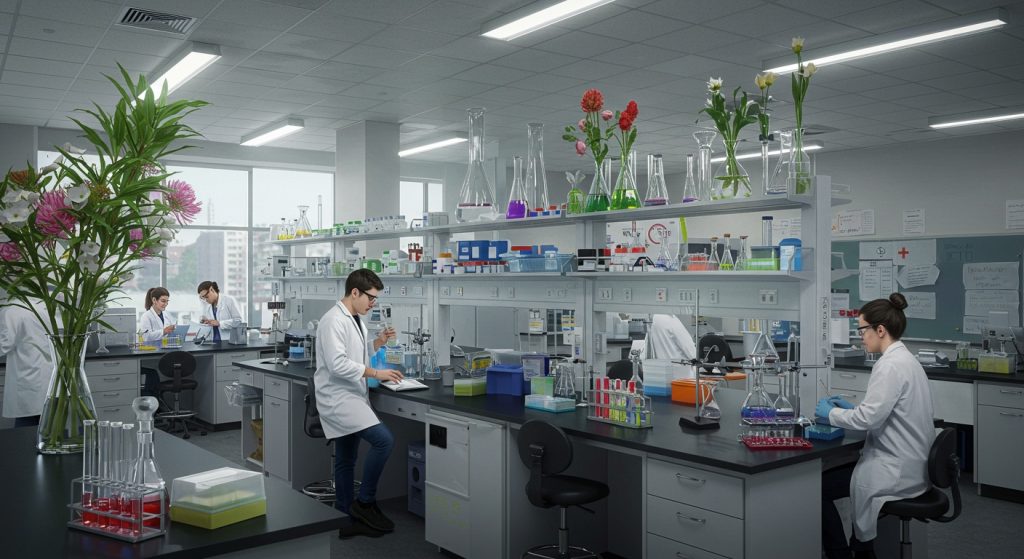Molecular biotechnology stands at the forefront of scientific innovation, revolutionizing medicine, agriculture. Industry. But, students and researchers embarking on this path encounter formidable complexities. Mastering advanced techniques like CRISPR-Cas9 gene editing, interpreting vast omics datasets from single-cell sequencing. Designing intricate synthetic biology circuits demands profound analytical rigor. The inherent variability in biological systems, coupled with ethical considerations surrounding novel therapeutic applications, often creates significant hurdles. Successfully navigating these multifaceted challenges, from ensuring experimental reproducibility in protein engineering to leveraging AI for drug discovery, empowers the next generation of biotechnologists to drive transformative solutions.

Understanding the Core of Molecular Biotechnology
Diving into the world of molecular biotechnology is like stepping into a vast, intricate biological machine. At its heart, molecular biotechnology is about understanding and manipulating the fundamental building blocks of life at a molecular level. Think of it as molecular engineering, where scientists use biological systems and their components to create new products and technologies for various applications, from medicine to agriculture.
To truly grasp the challenges, it’s essential to grasp some key players:
- DNA (Deoxyribonucleic Acid)
- RNA (Ribonucleic Acid)
- Proteins
- Genes
- Cells
- Recombinant DNA Technology
- CRISPR (Clustered Regularly Interspaced Short Palindromic Repeats)
The blueprint of life, carrying genetic instructions for development, functioning, growth. Reproduction.
Acts as a messenger, carrying instructions from DNA for controlling the synthesis of proteins. Some RNA molecules also have catalytic functions.
The workhorses of the cell, performing a vast array of functions, from catalyzing metabolic reactions to replicating DNA and transporting molecules.
Specific sequences of DNA that contain instructions for making a particular protein or functional RNA molecule.
The basic structural, functional. Biological units of all known organisms. Biotechnology often involves manipulating cells or their components.
This is a cornerstone of biotechnology. It involves combining DNA from different sources to create new genetic combinations. For example, inserting a human gene into bacteria to produce insulin.
A revolutionary gene-editing tool that allows scientists to make precise changes to DNA sequences, effectively editing genes with unprecedented accuracy.
The inherent complexity stems from the sheer scale and dynamic nature of these interactions within living systems. Unlike traditional engineering with predictable materials, living systems are incredibly complex, full of feedback loops, redundancies. Environmental influences, making precise manipulation a significant challenge.
Navigating the Labyrinth of Data and Bioinformatics
One of the most significant challenges in modern molecular biotechnology studies is the sheer volume of data generated. We’re living in the era of “omics” – genomics, proteomics, metabolomics, transcriptomics – each producing massive datasets detailing every aspect of a biological system. For instance, a single Next-Generation Sequencing (NGS) run can generate terabytes of genomic data from a biological sample.
Consider the task of sequencing the genome of a novel bacterium. You’re not just getting a simple list of letters; you’re receiving millions, sometimes billions, of short DNA fragments. Piecing these together, identifying genes, predicting protein functions. Understanding how they interact requires specialized skills and powerful computational tools. This is where Bioinformatics steps in.
Bioinformatics is an interdisciplinary field that develops methods and software tools for understanding biological data. It’s the bridge between biology and computer science. Without it, the vast ocean of molecular data would remain uninterpretable. For example, to identify a specific genetic mutation linked to a disease, researchers use bioinformatics algorithms to compare a patient’s DNA sequence against a reference genome, sifting through millions of bases.
| Challenge Aspect | Traditional Approach | Bioinformatics Solution |
|---|---|---|
| Data Volume | Manual interpretation (impractical) | Automated pipelines, high-performance computing |
| Data Complexity | Isolated analysis of single genes/proteins | Systems biology approaches, network analysis |
| Pattern Recognition | Human eye (limited) | Machine learning, statistical modeling |
| Knowledge Integration | Literature review (time-consuming) | Biological databases, semantic web tools |
For students and researchers, developing strong computational skills, particularly in programming languages like Python or R. Familiarity with bioinformatics tools (e. G. , NCBI BLAST, Galaxy) is no longer optional; it’s fundamental. Understanding statistical analysis is also crucial for drawing meaningful conclusions from complex datasets.
The Precision Problem: Experimental Design and Reproducibility
Molecular biotechnology experiments are notoriously sensitive. Achieving consistent and reproducible results is a constant uphill battle. Unlike experiments in physics or chemistry where variables might be more easily controlled, biological systems are inherently variable. Factors like cell line drift, subtle changes in media composition, slight temperature fluctuations, or even the time of day an experiment is performed can significantly impact outcomes.
Consider the process of cell culture. A seemingly minor contamination by bacteria or fungi can ruin weeks of work. Even within a supposedly identical batch of cells, there can be genetic drift or epigenetic changes that alter their behavior over time. Human error, though unintentional, can also creep in at various stages, from pipetting inaccuracies to incorrect reagent preparation.
A common challenge highlighted in scientific literature is the reproducibility crisis. A study published in Nature in 2012 found that researchers at Amgen could only reproduce 6 out of 53 “landmark” cancer studies. This highlights the critical need for meticulous experimental design and rigorous adherence to protocols.
To combat these issues, strong emphasis is placed on:
- Rigorous Experimental Design
- Standardization
- Quality Control
- Detailed Documentation
Planning experiments with appropriate controls (positive and negative), sufficient replicates. Statistical power calculations.
Adhering to validated protocols, using certified reagents. Maintaining consistent lab environments.
Implementing checks at every stage, from verifying reagent purity to monitoring instrument calibration.
Recording every step, observation. Deviation meticulously. This includes using Electronic Lab Notebooks (ELNs) to track experiments digitally.
# Example of a simplified experimental record entry
# This would typically be part of a larger ELN system Date: 2023-10-27
Experiment: Gene X Knockout in HEK293 cells
Researcher: Dr. J. Smith Cell Line: HEK293 (ATCC CRL-1573), Passage 15
Reagents: - CRISPR-Cas9 Plasmid (Addgene #XXXXX) - Lipofectamine 3000 (Invitrogen) Lot: YYYY - Opti-MEM I Reduced Serum Medium (Gibco) Lot: ZZZZ
Transfection Protocol: - Cells seeded at 2x10^5 cells/well in 6-well plate (Day -1) - Transfection mix prepared: 250uL Opti-MEM, 5uL Lipofectamine, 2. 5ug Plasmid DNA - Incubated 5 min at RT - Added to cells, incubated 48 hrs. Observations: - 24hr post-transfection: ~80% confluency, no visible toxicity. - 48hr post-transfection: Cells appear healthy, some GFP signal observed (plasmid contains GFP reporter). Next Steps: - Day 3: Harvest cells for genomic DNA extraction and PCR validation. Cultivate a meticulous approach to laboratory work. Interpret the “why” behind each protocol step. Embrace statistical thinking and learn about best practices for data normalization and analysis to ensure your findings are robust and reproducible.
The Ethical and Regulatory Minefield
The rapid advancements in molecular biotechnology, particularly in areas like gene editing and synthetic biology, often outpace our societal and legal frameworks. This creates a complex ethical and regulatory landscape that students and professionals must navigate carefully.
Consider the sensational case of “CRISPR babies” where a Chinese scientist, He Jiankui, announced the birth of gene-edited twins. This sparked global condemnation, not because the technology wasn’t powerful. Because it crossed major ethical lines regarding germline editing (changes passed to future generations) without adequate societal discussion or regulatory oversight. This incident highlighted the critical need for robust ethical guidelines and international consensus.
Key areas of concern include:
- Gene Editing
- Patient Data Privacy
- Intellectual Property
- Environmental Impact
The ethical implications of altering the human genome, particularly for non-therapeutic enhancement.
Handling sensitive genomic and health data requires strict adherence to regulations like GDPR (General Data Protection Regulation) or HIPAA (Health Insurance Portability and Accountability Act).
Patenting genes, organisms, or biotechnological processes raises complex questions about access and ownership of biological discoveries.
Releasing genetically modified organisms (GMOs) into the environment necessitates careful assessment of potential ecological effects.
Regulatory bodies like the U. S. Food and Drug Administration (FDA) and the European Medicines Agency (EMA) play crucial roles in ensuring the safety and efficacy of biotechnological products, from new drugs to diagnostic tests. Understanding their guidelines is paramount for anyone aiming to translate research into real-world applications.
Engage in discussions about bioethics. Stay informed about national and international regulations governing biotechnology. Consider taking courses or workshops focused on bioethics and regulatory affairs, as these are increasingly critical components of a successful career in the field.
Bridging the Gap: Interdisciplinary Collaboration
Molecular biotechnology is rarely a solitary pursuit. The challenges are too vast and multifaceted for any single discipline to tackle alone. Truly impactful advancements often emerge from collaborations that bridge expertise across diverse fields.
Think about the development of mRNA vaccines. This groundbreaking achievement in biotechnology wasn’t just the work of molecular biologists. It required:
- Molecular Biologists
- Chemists
- Immunologists
- Engineers
- Computational Biologists/Bioinformaticians
- Clinicians
To design the mRNA sequence and interpret its interaction with the immune system.
To develop the lipid nanoparticles (LNPs) that protect the mRNA and deliver it effectively into cells.
To grasp the immune response and how to optimize vaccine efficacy.
To scale up manufacturing processes for billions of doses.
To review data, predict structures. Optimize sequences.
To design and execute clinical trials and grasp patient responses.
The challenge lies in effective communication and understanding across these specialized domains. A molecular biologist might not fully grasp the intricacies of chemical synthesis. An engineer might not comprehend the nuances of cellular pathways. Miscommunication can lead to errors, delays. Missed opportunities.
Cultivate strong communication skills, both written and verbal. Seek out opportunities to collaborate with individuals from different scientific backgrounds. Attend interdisciplinary seminars and workshops. Learning to speak the ‘language’ of other scientific fields will be invaluable for tackling complex problems in biotechnology.
The Innovation Treadmill: Keeping Pace with Rapid Advancements
Perhaps one of the most exhilarating yet challenging aspects of molecular biotechnology is its incredibly rapid pace of innovation. What was cutting-edge last year might be standard practice today, or even obsolete. New technologies, tools. Methodologies emerge constantly, demanding continuous learning and adaptation.
Consider the journey from traditional cloning to CRISPR. Just a couple of decades ago, gene manipulation was a laborious process involving restriction enzymes and ligases. Now, with CRISPR, gene editing can be done with unprecedented ease and precision, significantly accelerating research. More recently, single-cell sequencing has revolutionized our understanding of cellular heterogeneity, allowing researchers to study gene expression at the resolution of individual cells, something unimaginable just a decade ago.
The integration of Artificial Intelligence (AI) and Machine Learning (ML) into drug discovery, protein folding prediction (e. G. , AlphaFold). Diagnostic development is another prime example of this relentless innovation. Researchers now leverage AI to sift through vast chemical libraries, predict drug candidates. Accelerate the research pipeline.
The challenge isn’t just learning new techniques. Also understanding their implications, limitations. How they integrate with existing knowledge. Staying relevant in such a dynamic field requires a proactive approach to learning.
Embrace a mindset of lifelong learning. Regularly read scientific journals (e. G. , Nature Biotechnology, Cell, Science), attend virtual and in-person conferences. Participate in webinars and online courses. Consider specializing in a rapidly evolving niche. Always maintain a broad awareness of the field’s overall trajectory. Networking with peers and mentors who are at the forefront of these innovations can also provide invaluable insights and opportunities for growth.
Conclusion
Molecular biotechnology, while profoundly challenging, is also immensely rewarding. Overcoming the hurdles of intricate pathways and vast data sets, such as those encountered in single-cell genomics or synthetic biology, demands more than just rote memorization; it requires a strategic mindset. My personal tip is to embrace the ‘why’ behind every concept; understanding the underlying biological rationale, rather than just the mechanism, transforms complexity into clarity. For instance, truly comprehending the CRISPR-Cas9 system’s mechanism is amplified when you grasp its revolutionary therapeutic potential, as seen in recent clinical trials for sickle cell disease. To truly navigate these complexities, actively engage with current trends like AI-driven drug discovery platforms or advanced biomanufacturing techniques. Seek out collaborative projects; I’ve found that discussing a baffling concept, like the nuances of post-translational modifications, with peers often unlocks new perspectives. Don’t be afraid to experiment, even if it means iterating through failed PCRs; each ‘failure’ is a data point refining your understanding. Your journey through molecular biotechnology is a testament to resilience. By adopting these proactive strategies – deep conceptual understanding, collaborative learning. A relentless curiosity – you are not just studying a field, you are shaping the future of medicine and environmental solutions. Go forth and innovate.
More Articles
Ace Your College Life: Balancing Academics and Social Success
Get Real-World Ready: Experiential Learning Opportunities at Public Universities
Beyond the Diploma: Exciting Career Paths for State University Alumni
Ensuring Excellence: Accreditation and Quality in State University Programs
FAQs
Molecular biotech seems incredibly complex. How do I even begin to wrap my head around it all?
Break it down! Instead of trying to grasp everything at once, focus on understanding foundational concepts thoroughly. Use visual aids, draw diagrams of pathways. Try explaining complex ideas to a friend. Repetition and active recall are your best tools here to build a solid base.
This field changes so fast! How can I possibly keep up with all the new discoveries and technologies?
It’s a challenge. You can manage it. Make it a habit to regularly read reputable scientific journals (even just abstracts), follow key research institutions. Attend webinars or conferences if possible. Connect with peers and professors who can share insights. Focus on understanding the principles behind new tech, not just memorizing every new tool.
My experiments keep failing. It’s super frustrating. Any tips for lab work challenges?
Lab work is all about troubleshooting! First, meticulously review your protocol. Did you miss a step? Check reagent expiry dates and concentrations. Was your equipment calibrated? Don’t be afraid to ask for help from TAs or experienced lab mates. Keep a detailed lab notebook – it’s crucial for identifying variables and learning from mistakes. Patience is key!
I’m a bit intimidated by the data analysis and bioinformatics side of things. What’s the best way to get comfortable with it?
Start small and learn by doing. Many online platforms offer free or affordable courses in programming languages like Python or R, which are essential for bioinformatics. Practice with publicly available datasets. Don’t aim to be an expert overnight; focus on understanding the logic behind the tools and interpreting the results. Collaboration with peers who have stronger computational skills can also be very helpful.
Molecular biotechnology pulls from so many different sciences. How do I manage learning across biology, chemistry. Even computer science?
Embrace it! The interdisciplinary nature is what makes the field so exciting. Focus on how these different areas connect and complement each other. For example, grasp how chemical principles dictate protein function, or how computational tools can review biological data. You don’t need to be an expert in every single discipline. Aim for a strong foundational understanding in each. Be open to learning new skills as needed.
What about the ethical issues? How do we navigate the moral complexities in this field?
Ethical considerations are paramount in molecular biotechnology. Engage in discussions, read papers on bioethics. Think critically about the societal implications of new technologies like gene editing or synthetic biology. Understanding different perspectives and developing your own informed stance is crucial. It’s not about having all the answers. About asking the right questions and promoting responsible innovation.
The workload for these studies feels overwhelming. How do I avoid burning out?
Effective time management is your best friend. Prioritize tasks, create a study schedule. Stick to it as much as possible. Don’t underestimate the power of short breaks. Remember to schedule time for non-academic activities that help you recharge, whether it’s exercise, hobbies, or spending time with loved ones. It’s a marathon, not a sprint, so self-care is vital for sustained success.



